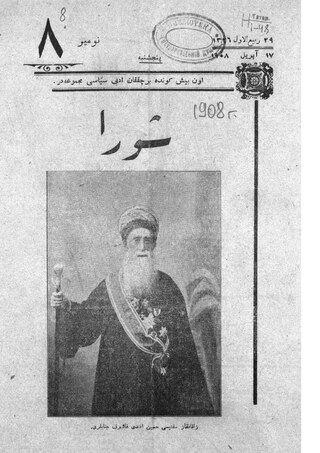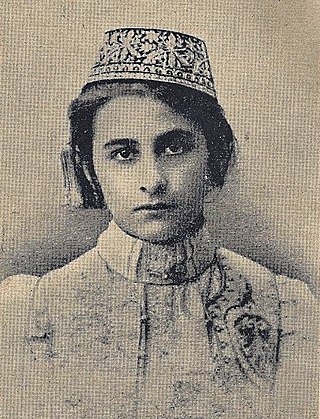
Ğabdulla Möxəmmətğərif ulı Tuqay was a Volga Tatar poet, critic, publisher, and towering figure of Tatar literature. Tuqay is often referred to as the founder of modern Tatar literature and the modern Tatar literary language, which replaced Old Tatar.

Crimean Tatar, also called Crimean, is a Kipchak Turkic language spoken in Crimea and the Crimean Tatar diasporas of Uzbekistan, Turkey and Bulgaria, as well as small communities in the United States and Canada. It should not be confused with Tatar, spoken in Tatarstan and adjacent regions in Russia; the two languages are related, but belong to different subgroups of the Kipchak languages, while maintaining a significant degree of mutual intelligibility. Crimean Tatar has been extensively influenced by nearby Oghuz dialects and is also mutually intelligible with them to varying degrees.

Bakhchysarai is a city in the Autonomous Republic of Crimea, Ukraine. It is the administrative center of the Bakhchysarai Raion (district), as well as the former capital of the Crimean Khanate. Its main landmark is Hansaray, the only extant palace of the Crimean Khans, currently open to tourists as a museum. Population: 27,448 .
The Jadids were a political, religious, and cultural movement of Muslim modernist reformers within the Russian Empire in the late 19th and early 20th century. They normally referred to themselves by the Turkic terms Taraqqiparvarlar ("progressives"), Ziyalilar ("intellectuals"), or simply Yäşlär/Yoshlar ("youth"). The Jadid movement advocated for an Islamic social and cultural reformation through the revival of pristine Islamic beliefs and teachings, while simultaneously engaging with modernity. Jadids maintained that Turks in Tsarist Russia had entered a period of moral and societal decay that could only be rectified by the acquisition of a new kind of knowledge and modernist, European-modeled cultural reform.

Islam in Ukraine is a minority religious affiliation with Muslims representing around 5% of the total population as of 2016. The religion has a long history in Ukraine dating back to Berke Khan of the Ulug Ulus in the 13th century and the establishment of the Crimean Khanate in the 15th century.
The Union of the Muslims of Russia was a political organisation and party of Muslims in the late Russian Empire. The organisation was founded during the 1905 Revolution and came to an end after the February Revolution. Its political agenda was liberal-constitutional, closely aligned to that of the Kadet Party; the Islamic reform movement of Jadidism was an important influence. The Ittifaq was dominated by Volga Tatar intellectuals, but also included Muslim representatives of other ethnicities such as Azeris, Crimean Tatars, Caucasians and Central Asians.

Ismail bey Gasprinsky was a Crimean Tatar intellectual, educator, publisher and Pan-Turkist politician who inspired the Jadidist movement in Central Asia. He was one of the first Muslim intellectuals in the Russian Empire, who realized the need for education and cultural reform and modernization of the Turkic and Islamic communities. His last name comes from the town of Gaspra in Crimea.
Necip Hablemitoğlu was a Turkish historian and intellectual. He was assassinated in front of his home in 2002. The perpetrators of this assassination have still not been found. In Ergenekon trial testimony, however, detained suspects Osman Yıldırım claimed that Osman Gürbüz killed him by the motivation of detained suspects Veli Küçük and Muzaffer Tekin for a false flag operation.

Abdurresid Ibrahim was a Russia-born Tatar Muslim Alim, journalist, and traveller who initiated a movement in the first decade of the 20th century to unite the Crimean Tatars. He visited Japan in Meiji period and became the first imam of Tokyo Camii.
Al-Tilmiz was an Arabic language weekly newspaper published from Saint Petersburg, Russia between 1906 and 1907. The first issue was published on July 21, 1906. The publication was directed towards the Caucasian community in the capital of the Russian empire.

Olga Lebedeva was a Russian translator, linguist and Orientalist. She was a founder of the Society of Oriental Studies in St Petersburg. Writing as Madame Gülnar, Gülnar Hanım, Gülnar Lebedeva and Olga de Lebedeff, she was one of the first to introduce Russian literature to Turkey. She is recognised for her pioneering contributions to the literary networks between the Ottoman and the Russian empires at the end of the 19th century.

Rizaeddin bin Fakhreddin was a Bashkir and Tatar scholar and publicist who lived in the Russian Empire and the Soviet Union. His numerous works on religious, political and pedagogical subjects were a part of the Jadidist movement, and the journal Shura (magazine), which he created and published, was an important way of political discussion for Muslims in the late Empire.

Shura was a biweekly literary and political newspaper supplement published in Orenburg, Russian Empire, between January 1908 and January 1918. The magazine featured articles written in both Turkish and Tatar languages. It was one of the most important Tatar language publications.
The earliest Crimean Tatar literary works are dated back to the times of the Golden Horde, while its golden era took place in the times of Crimean Khanate.

Asan Sabri Ayvazov was a Crimean Tatar politician, journalist, writer, educator, and pedagogue in the Russian Empire. Active from the early 1890s until the late 1920s, Ayvazov was a preeminent figure among the Crimean Tatar intelligentsia, and one of the leaders of the Crimean Tatar nationalist movement.

Şefiqa Gaspıralı was a Crimean Tatar feminist leader who was editor-in-chief and publisher of the first women's magazine, a member of the Presidency Council of the Kurultai, and a deputy for two terms in the Crimean People's Republic. She was also a kindergarten teacher.

Osman Nuri-Asan oğlu Aqçoqraqlı, also written as Aqchoqraqli or Akchokrakli, was a Crimean Tatar writer, journalist, historian, archaeologist, ethnographer, and teacher.

Terciman or Tercüman was a Pan-Turkist weekly magazine published between 1883 and 1918 by Crimean Tatar intellectual and educator Ismail Gasprinsky in Bakhchysarai. It was the first Crimean Tatar periodical, and the main publication of Turkic peoples in the Russian Empire.
Taner Murat is a Romanian Tatar writer, poet and translator.

Ishig was the first Azerbaijani-language women's publication. The first issue of newspaper was published on January 22, 1911, and its publication continued until the end of 1912, during which 68 issues were released.














